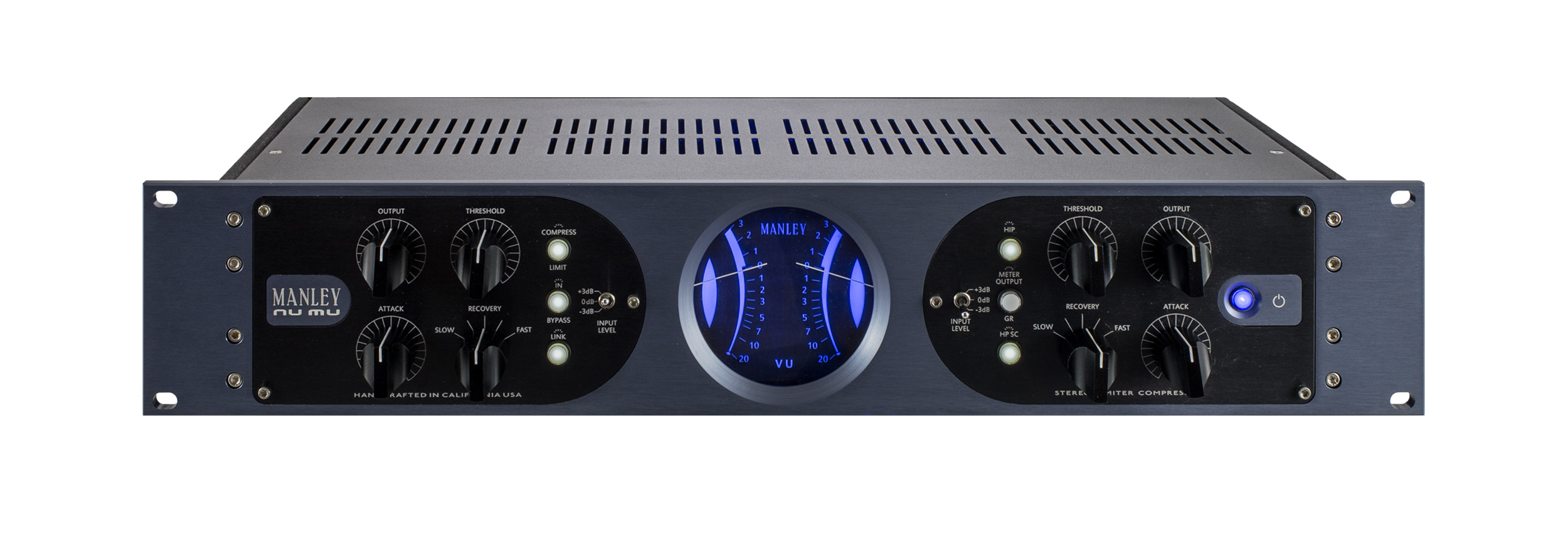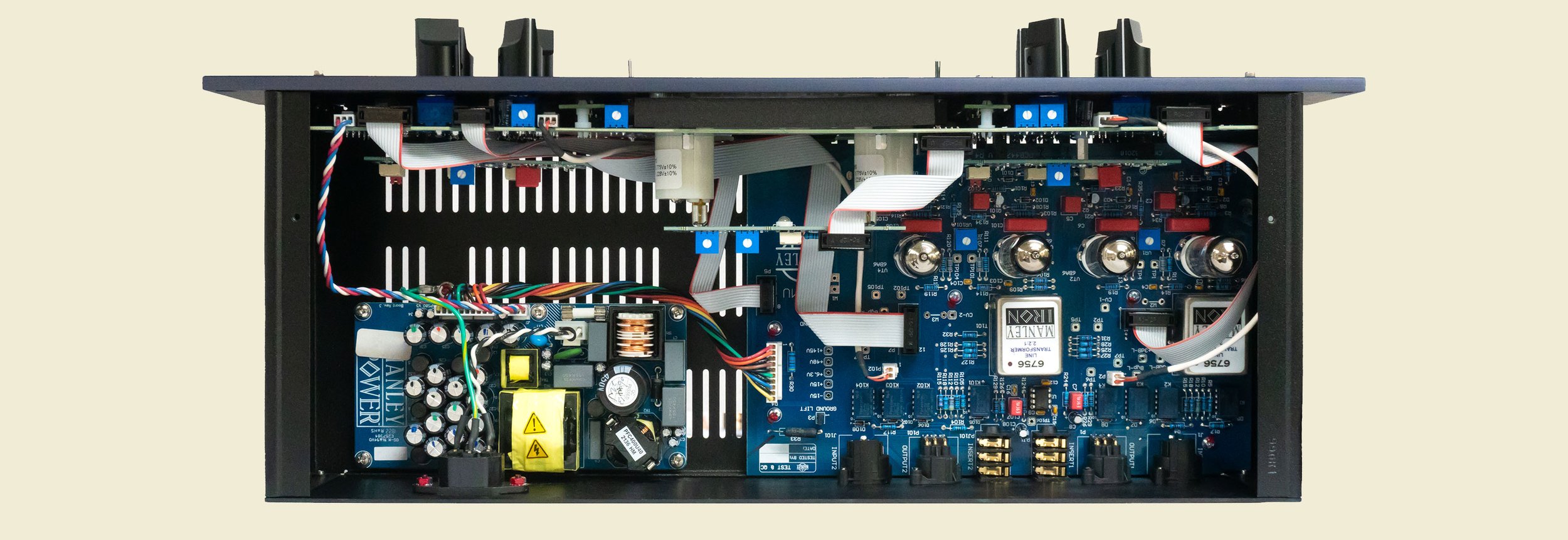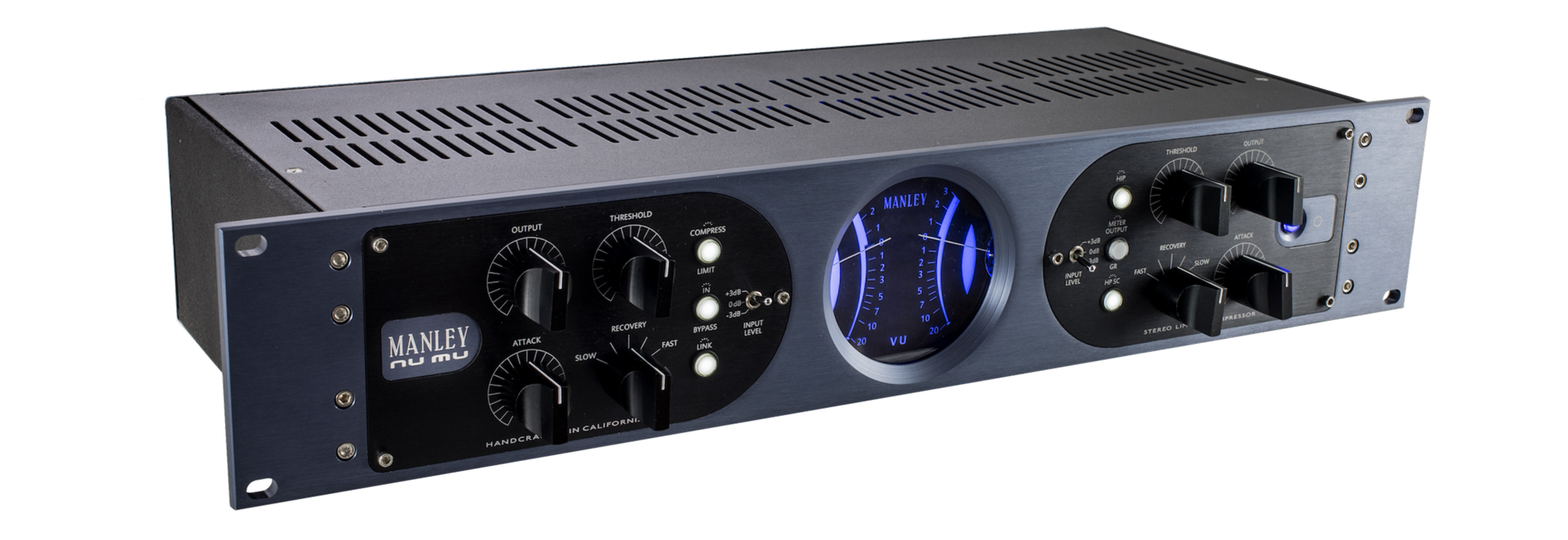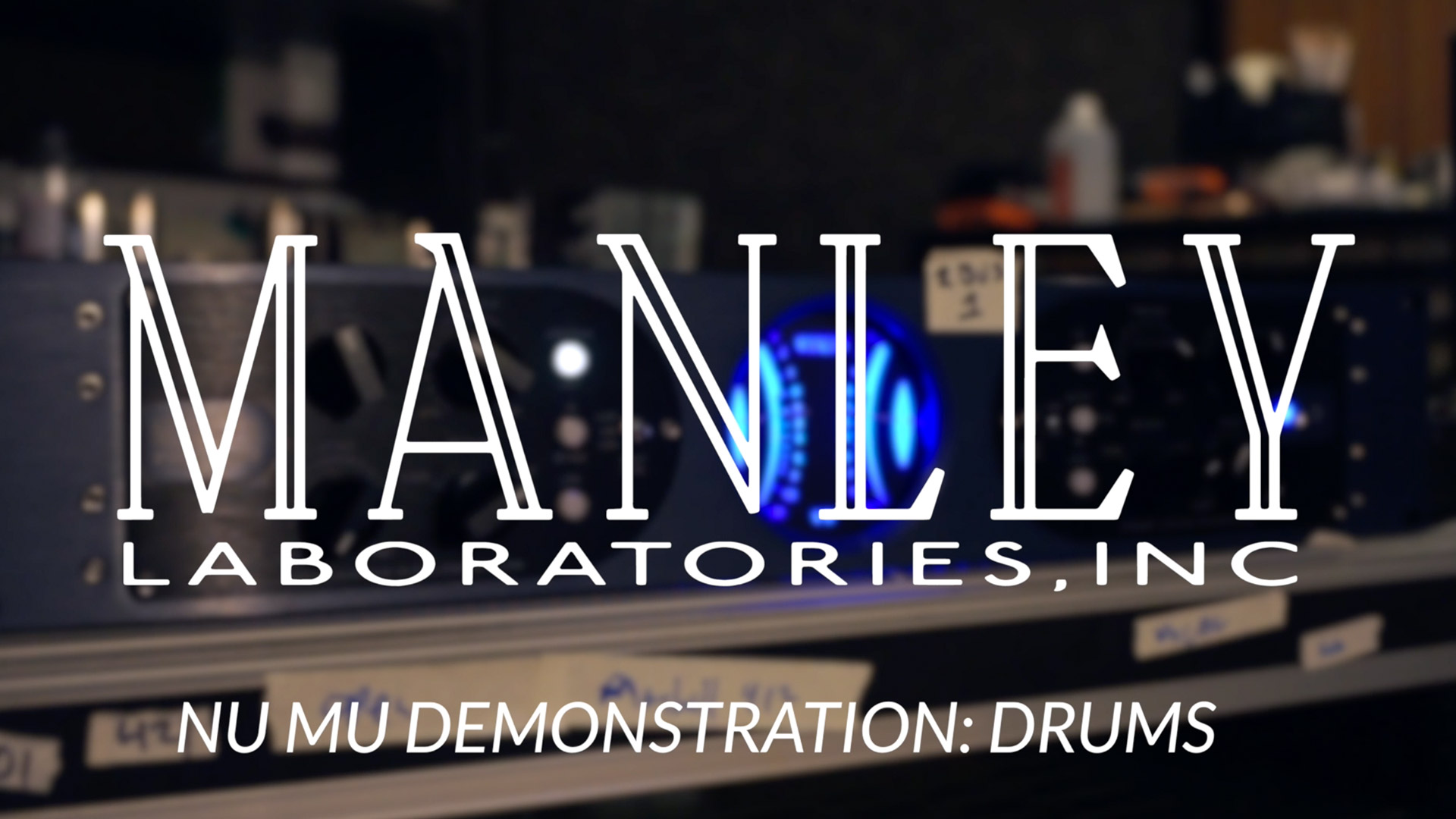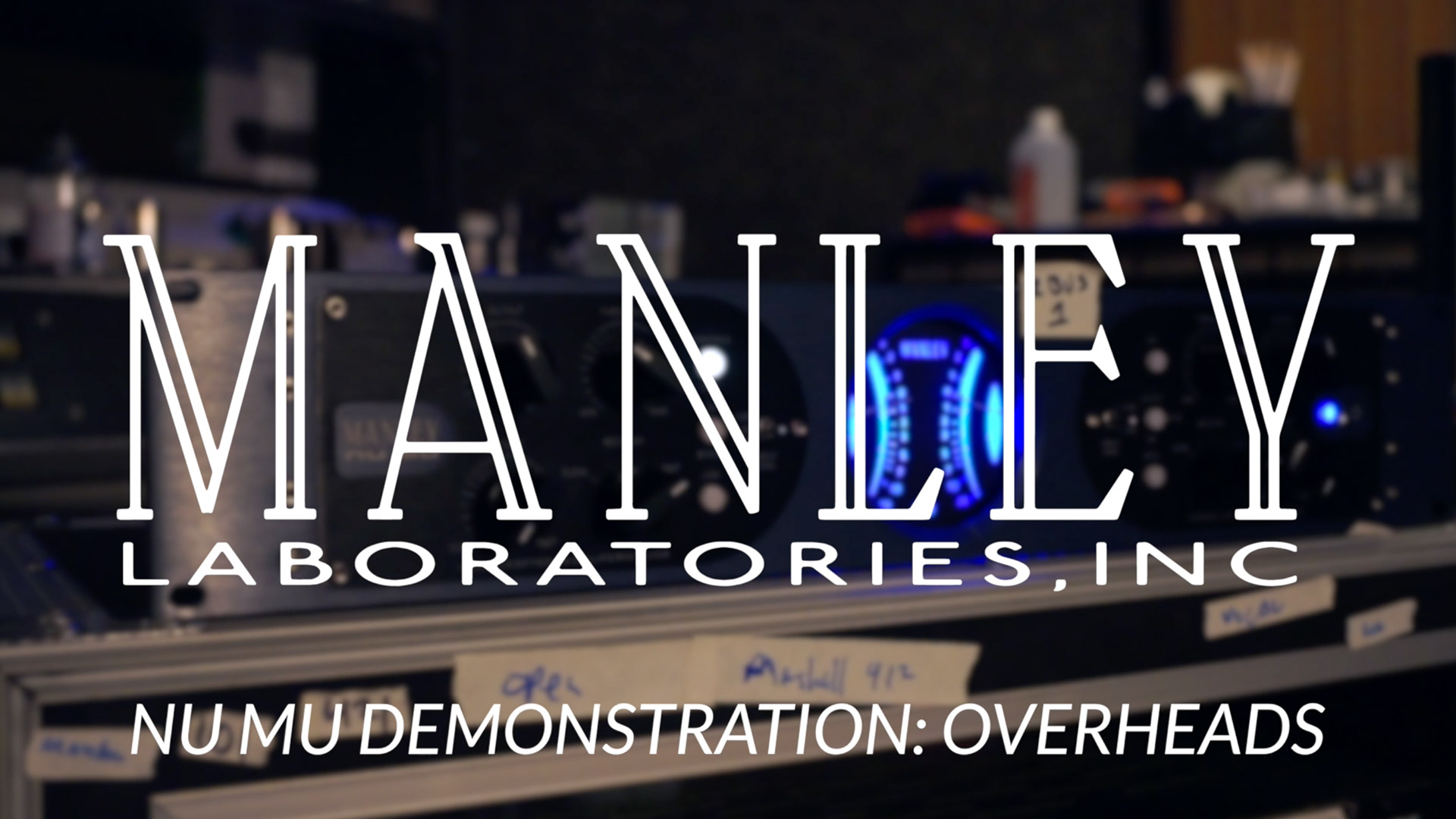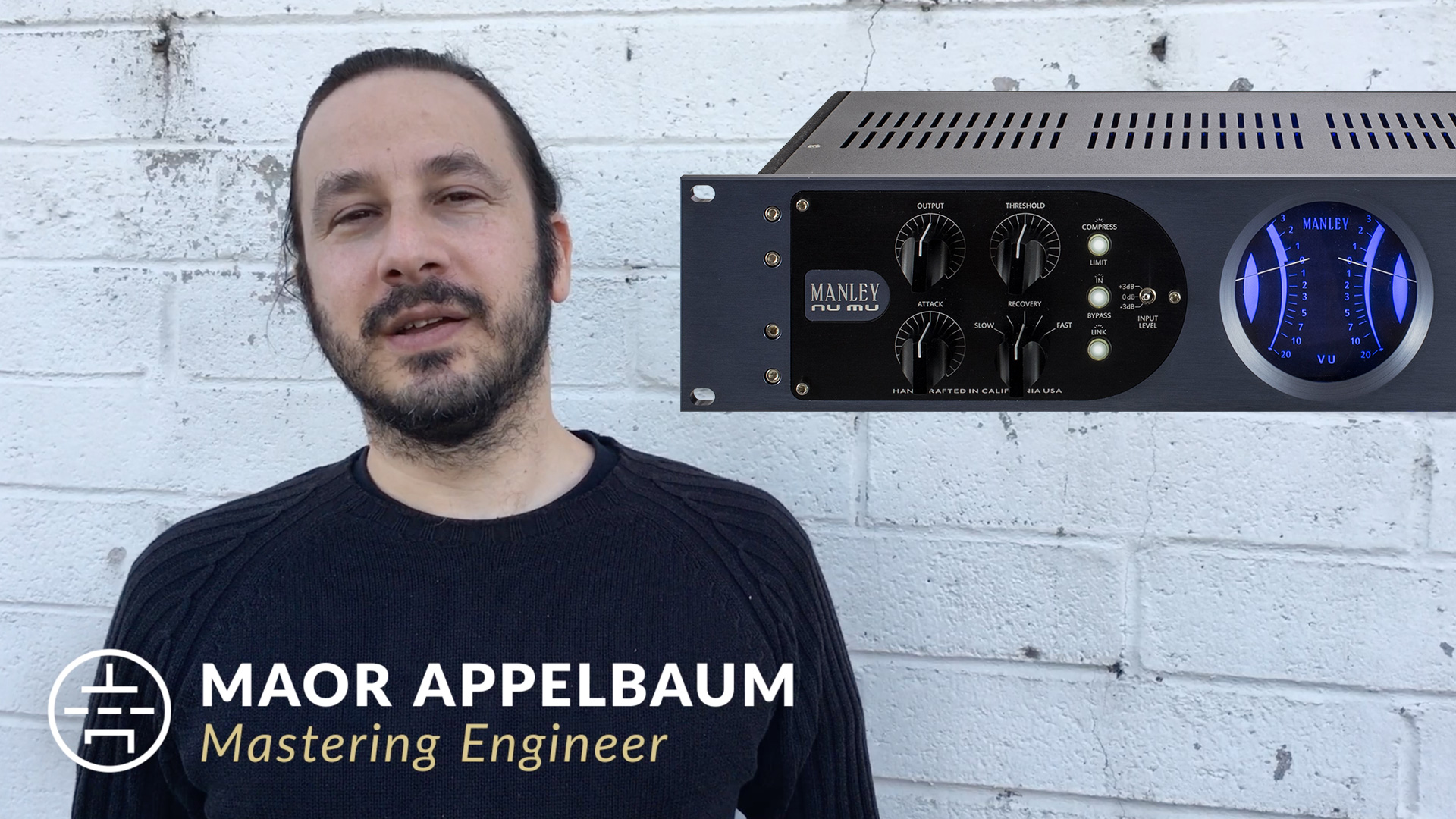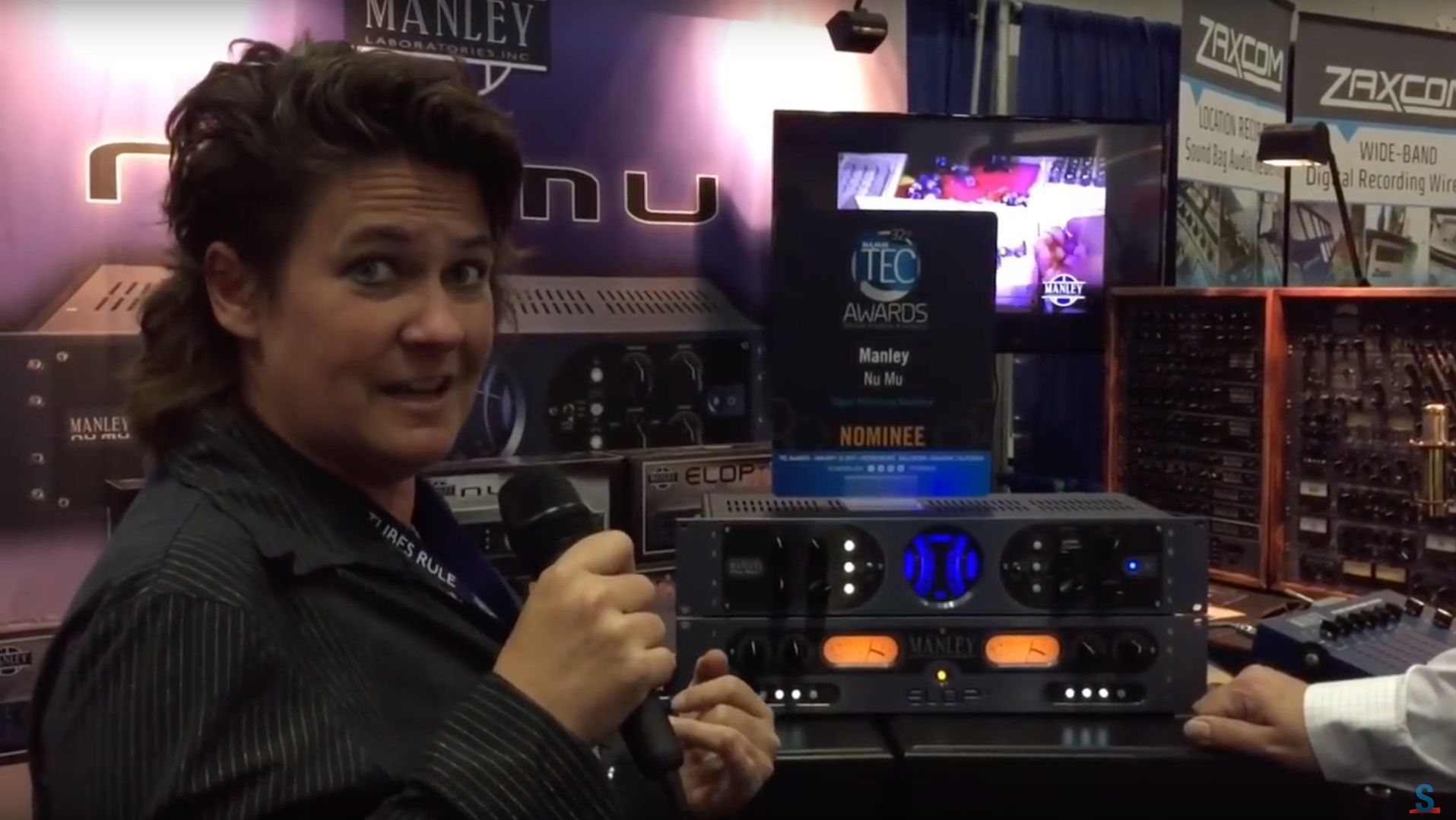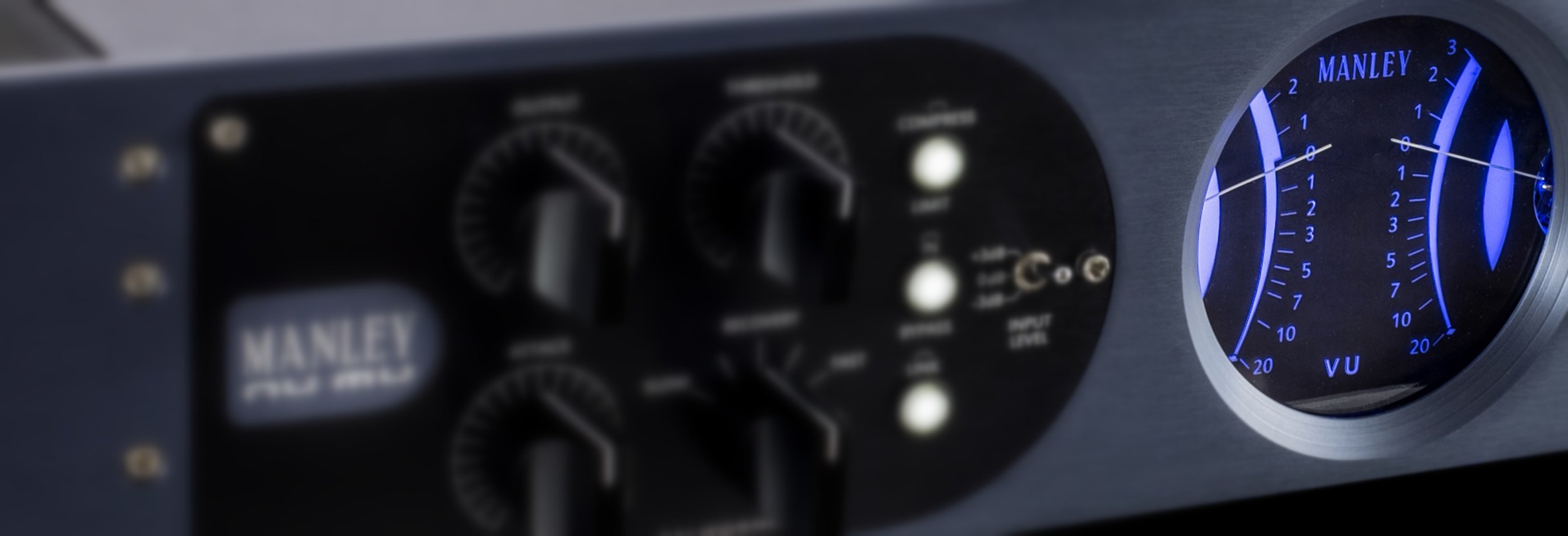
The Manley Nu Mu Stereo Limiter Compressor uses the special T-Bar mod tube front end of the legendary Variable Mu® with same super smooth side chain and timing characteristics followed by a high voltage discrete and FET solid-state amplifying and output stage for a faster and punchier audio path. It is like a “clean” version of the Variable Mu, especially suited for modern digital and electronic music where you don’t necessarily need to color or mask the sound like we did in the early days of digital.
Featuring Manley’s new HIP function, the Manley Nu Mu finesses dynamic control to bring up lower level details without knocking the life out of exciting transients. Smartly engineered to build efficiently and esthetically designed to elicit ravishing compliments from your clients, both visually and ergonomically, the Manley Nu Mu breaks new ground in performance and value, all proudly hand-built in California, of course!
DRIVEN BY MANLEY POWER®
NOTES FROM EVEANNA MANLEY:
"So: taking the smoothest & best version of the Variable Mu - the T-BAR mod where we use two 6BA6 Pentodes strapped as triodes to achieve characteristics just about identical to the revered 6386 tubes of the original version (or the Fairchild) - we have the same front end as the Variable Mu. From there we then go into high voltage discrete transistor and FET amplification and drive circuitry. No chips! So this is, yes, less expensive than the all-tube Variable Mu; and also being transformerless on the outputs, very much the clean version of the Variable Mu.
"Let’s think back to the early 1990’s when the Variable Mu first came out. Recording was a different world. There was still plenty of recording to tape occurring in the big studios. And then digital was not really excellent yet. It was flat sounding and a bit "glary". A big round heavy-handed vibey sound like The Variable Mu was exactly what was needed then. Skipping forward to today, we have really excellent digital converters, and of course it is our de facto standard now. So we don’t need this big masking sound for everything we are doing today, especially for electronic music / EDM where we want to retain super crisp and punchy sounds. We don’t want to add more vibe or slow down the sound. Thus a clean, fast and punchy solid state limiter compressor is what the world needs now. And here is what we have with the Manley Nu Mu – and for all of our individual musician and home recording customers, it is very well-priced for them."
NU MU vs. STEREO VARIABLE MU (with T-BAR)
As you can see from this graphic generated by our Audio Precision measurement system, both the LIMIT and COMPRESS reduction curves from the NU MU are remarkably similar to those from a T-Bar modded Stereo Variable Mu. Same curves, same legendary smoothness.
NU MU VIDEOS
"...it excels at controlling the level of a source or mix, enabling you both to add colour to it and to sculpt the character of its transients...a worthy addition to Manley's product line…I could easily envision having a Nu Mu sitting permanently across my main mix bus."
- Bob Thomas, Sound On Sound (February 2021) -

DETAILS
1. OUTPUT CONTROL. The OUTPUT control is available on both the L and R channels. It adjusts the output level of that audio channel. Unity gain is about the ninth marking, or 11 o'clock.
2. THRESHOLD CONTROL. The THRESHOLD control is available on both the L and R channels. THRESHOLD or gain reduction sets the necessary amplitude for compression or limiting to take effect. The most extreme effect is when the control knob is set to MIN or fully counter-clockwise.
3. COMPRESS / LIMIT SWITCH. This switch allows the Nu Mu to use two different compression ratios, offering either Compression at approximately 3:1 when the switch is engaged and illuminated, or Limiting at approximately a 10:1 ratio.
4. IN / BYPASS SWITCH. The BYPASS switch in the Nu Mu is a ‘Hardwire’ bypass for maximum performance. If the switch is engaged and illuminated to the “IN” position the audio will pass through either the Limiter or Compressor, so all the front panel controls will function. Use this switch to verify that the limiting or compressing is not messing up the original sound but enhancing it or at least leveling the volume.
5. VU METER. The Large custom VU meters allow easy tracking of both channels with the Nu Mu. It shows the amount of gain reduction in dB from the 0 dB mark, when the switch (7) is set to REDUCTION. When this switch is selected to O/P and illuminated, the meter measures the output in decibels.
6. HIP CONTROL. The "Hip" control allows compression to happen at lower volumes (lower in the dynamic range spectrum) but leaves the louder dynamics alone while still compressing the overall signal. You get louder soft sections and original dynamics of the louder sections. Previously the only way to get around this issue has been parallel compression, where the compressed signal is mixed with the uncompressed signal. Our "Hip" control achieves a similar effect while being easier to use, requiring less hardware (no need for extra mixing externally).
7. METER SELECT SWITCH. The Meter select switch allows the user to monitor either Gain Reduction or the Output of the unit. When the switch is engaged and illuminated, the output of the particular channel you are monitoring is visible in the corresponding VU Meter.
8. ATTACK CONTROL. The ATTACK control determines how long the compressor takes to respond to signals above the threshold. The Attack control is continuously variable and determines the necessary length of a transient to initiate gain reduction.
With 63% gain reduction: SLOW 0.13s, MID 0.07s, FAST 0.013s.
With 90% gain reduction: SLOW 0.64s, MID 0.35s, FAST 0.064s.
Fully counter clockwise at the slowest setting will prevent most percussive signals from causing limiting or compression. It is available on both the left and the right channel.
9. RECOVERY CONTROL. The RECOVERY control determines how long the compressor takes to recover after the signal falls below the threshold level.
With 63% gain reduction recovery, five selections: 0.1s, 0.16, 0.32, 0.64s, 1.7s.
With 90% gain reduction recovery five selections: 0.227s, 0.368s, 0.736s, 1.6s, 3.87s.
10. LINK FUNCTION. When The LINK function is used it links the two Stereo channels together. The Left channel controls become the master linking THRESHOLD, ATTACK & the RECOVERY CONTROLS.
11. INPUT LEVEL SWITCH. The Input Level is controlled by a toggle switch. There is an Input Level control for each cannel. Three levels of attenuation are available. +3dB, 0dB and -3dB.
12. HP SC SWITCH. The High Pass Side Chain filter is factory set a 100Hz. When this switch is engaged and illuminated, everything above 100Hz will have the effect of limiting or compression. Useful if you want the bass to come through with full impact and limit or compress everything else.
13. POWER SWITCH. The Power Switch glows a soft blue color when an IEC power lead is connected to the unit. This indicates that the Nu Mu is in STANDBY mode. Engaging the power switch takes the Nu Mu out of standby mode and into warm-up mode. The power switch will illuminate to a brighter blue and the backlit VU meters will start to flash. This warm-up process last 30 seconds, after which the MUTE relays will lift and the VU meters will stop flashing.
SPECIFICATIONS
Manley IRON® input transformers
4 x hand-matched 6BA6 vacuum tubes
Transformer-Balanced XLR inputs
Manley HIP function raises soft dynamics without squashing louder passages
MANLEY POWER® High Voltage Switched Mode Power Supply custom designed for our vacuum tube audio circuits
INPUT Level Preset 3-way switches -3dB, 0, +3dB
Continuously variable OUTPUT level controls
Unity Gain set INPUT to "0" and OUTPUT control to 11 o’clock. (Input source Z= 150 Ohms, Output load Z= 100 kOhms)
Maximum input level: (1 kHz Sine, <0.3% THD+N)
-3 = +25 dBu
0 = +21 dBu
+3 = +18 dBuMaximum GAIN: 13dB
GAIN makeup: 10dB (gain above unity)
Output Headroom: 23dB (referenced to +4dBu)
Variable ATTACK control: 13msec - 130msec
RECOVERY switch 5 steps: 0.1s, 0.16s, 0.32s, 0.64s, 1.7sec.
Continuously variable THRESHOLD controls
Hardwired Relay Bypass Switch
Ratio Mode switches between LIMIT (1.5:1 to 12:1) or COMPRESS (1.2:1 to 3:1)
HP SC: High Pass Side Chain Filter -3dB @ 100Hz @ 6dB per Octave
Stereo Link establishes Left-Master dynamic control for THRESHOLD, ATTACK, and RECOVERY controls
Beautiful illuminated stereo VU meters read Gain Reduction or Output Level
Sidechain INSERT per channel via 1/4" TRS jack TIP=SEND, RING=Return, SLEEVE=Ground
Maximum Output: +27dBu (18Vrms) into 100K Ohm load; +24.5dBu (13Vrms) into 600 Ohm load. (1Khz Sine, < 0.3% THD+N, BW 20Hz - 20kHz).
Frequency Response: - 0.8dB @ 20Hz, -0.5dB @ 50kHz
Total Harmonic Distortion: <0.05% THD+N (1kHz Sine, +4dBu, BW: 20Hz - 22kHz)
Noise floor: -85dB typical (BW: 20Hz - 22kHz)
Dynamic Range: 112dB
Signal to Noise Ratio: 89dB (referenced to +4dBu)
Common-Mode Rejection Ratio (CMRR): 74dB (BW: 20Hz - 22kHz, +4dBu, 1kHz Sine)
Transformerless Impedance-Balanced Output Impedance: 100 Ohms
Input Impedance: -3dB= 1 kOhms, 0dB= 2.5 kOhms, +3dB= 4.5 kOhms
AUTOMUTE warmup delay: 30 Seconds
Power consumption: 35 Watts
Standby Power Consumption: 0.5 Watts
Operating mains voltage: 90 to 254 VAC (internal universal supply)
Mains Voltage Frequency: 50-60Hz
Dimensions: 19" x 3 1/2" x 7" (occupies 2u)
Unit Weight: 8.5 lbs.
Shipping weight: 11.5 lbs.
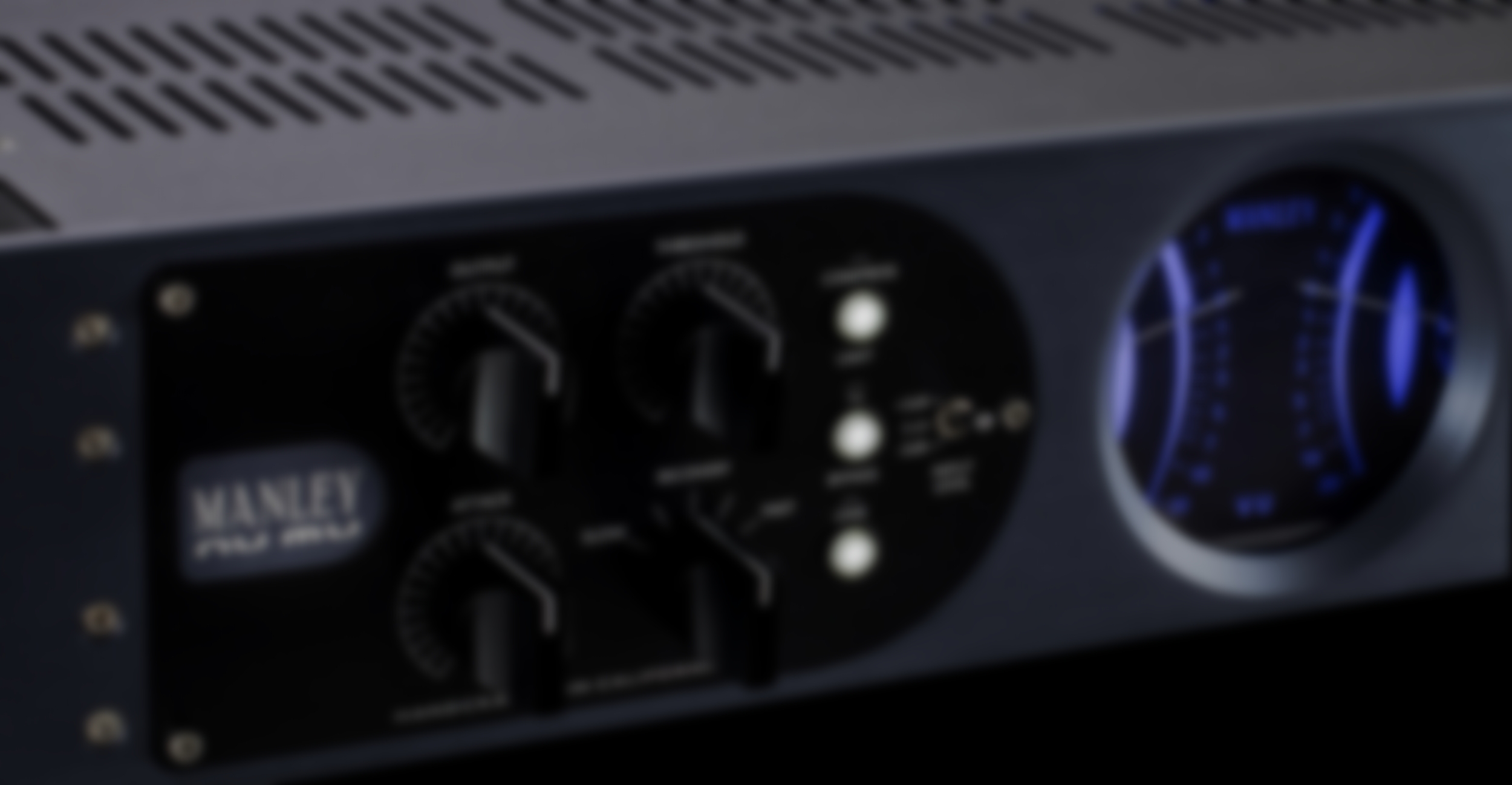
REVIEWS
"...it excels at controlling the level of a source or mix, enabling you both to add colour to it and to sculpt the character of its transients...a worthy addition to Manley's product line…I could easily envision having a Nu Mu sitting permanently across my main mix bus."
- Bob Thomas, Sound On Sound (February 2021)
"I love the venerable Variable Mu, but for my money, the NU MU will probably prove more useful and flexible in my day-to-day productions, mixing, and mastering…like the Variable Mu, Massive Passive, and other Manley gear, the NU MU can make a great recording into a great master."
- Adam Kagan, Tape Op #124 (March / April 2018)
"…carries on the tradition of the original unit with modern additions and a totally distinct sound of its own. It is versatile and great for any source...it adds a finished polish with an average level and density increase, without adding distortion or reducing transparency. Highly recommended!"
- Barry Rudolph, MIXonline (May 2018)
"Manley’s Nu Mu is not a Variable Mu ‘lite’ but a new compressor / limiter…with a more transparent sound perfectly suited to electronic music…and its price makes it accessible for home or project studios!"
"The Nu Mu is a very nice box that isn’t just a 'Variable Mu Lite'. It stands on its own as a modern mastering compressor that also makes a stellar mix-finishing tool on the 2-bus...this is a bargain price for a pro level device, and well worth it for project studios and pro rooms alike."
- Paul Vnuk Jr, Recording Magazine (Aug 2017)
"The Nu Mu sounded great with every style of music that I put it through...a high quality and versatile limiter compressor. I think Manley hit this one out of the park with its much lower price over their Variable Mu, its sound and features."
- Glenn Bucci, SOS Forum Review (Feb 2017)
"The Nu Mu always delivers excellent results when the intended purpose is the careful compression and refinement of mixes and individual tracks without any obvious coloration."

DOWNLOADS
FREQUENTLY ASKED QUESTIONS
FAQ #1 – Hi. I watched a video on the nu mu compressor on drums and I was impressed with how the punch increased. Can you help me understand how the compressor does that? isn't working.
Simply put, the Manley NuMu is fast, aggressive, and mid-range driven, which makes it especially great for drums, bass guitar, and mix-bus duties.
Also, the quad of 6BA6 tubes and Manley IRON® input transformers add major mojo!
Lastly, the HIP function compresses the quieter passages while leaving the louder dynamics untouched, which is another feature that makes it amazing on drums.
FAQ #2 – This thing isn't working. I just bought it. For this amount of money, it needs to function.
OK, listen up: the XLR INPUT is TRANSFORMER-COUPLED so that means you HAVE TO have something connected to all of the pins.
PIN 1: GROUND
PIN 2: HOT (+) POSITIVE
PIN 3: COLD (-) NEGATIVE
You cannot "float" Pin 3. You can GROUND it if you are driving it from an unbalanced source. But you cannot hook it up to "nothing".
Pay attention when interfacing with some of these interfaces like your Apollo. If you are using TRS - XLR cables, make sure that it is wired:
TRS TIP = HOT (+) to XLR Pin 2
TRS RING = COLD (-) to XLR Pin 3
TRS SLEEVE = GROUND to XLR Pin 1
or
TS - XLR cable, make sure it is wired:
TS TIP = HOT (+) to XLR Pin 2
TS SLEEVE = GROUND to XLR Pin 1 AND Pin 3
FAQ #3 - No, I mean it was working and now it won’t power up at all! No lights, nada.
Aw, sorry. The PSU module has failed. Good news is that it is super easy to replace. Just open up the top lid, and unscrew and unplug the old one and screw in the new one and plug it in! You can either request the PSU assembly be sent to you for you to replace or you can request an RA# for you to send the unit to us for us to replace it. Head on over to the Tech Support section of the website in order to get that rolling.
FAQ #4 - Whoops, I mean the unit is working but the meters just died!
Pop the lid and make sure those grey ribbon cables did not come loose! Make sure the cable ends are pressed firmly into their black IDC sockets.
FAQ #5 - I'm really interested to buy the device but it's a big no-go for me that you can't link the output levels. Is there any possibility to get the device with output link or fixed output levels?
Sorry they are individual pots and they are not linked or mechanically ganged. Even if they were on one giant stereo ganged analog potentiometer, you are not guaranteed perfect matching between channels like a computer plugin. Having two individual knobs carries an advantage that you are able to address each channel separately and make fine trim adjustments.
Use two hands, turn both knobs at once. This is what people do with analog gear! Record with your ears!

